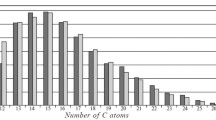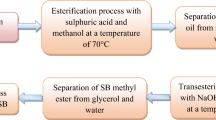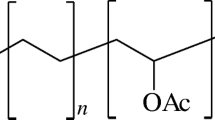We have established the effect of production temperature conditions on the performance characteristics of the composite additive Evropris for diesel fuels, including cetane-booster, pour-point depressant, antiwear, smoke-suppressant, and dispersant components. We determined the optimal temperature for mixing the individual components of the additive that ensures maximum improvement in the cetane number and anti-wear properties of the diesel fuel and reduced exhaust smoke. The composite additive improves the properties of the fuel as a result of the synergistic effect between its components. We use a semi-empirical quantum chemical method to estimate the excitation energy for the individual components of the additive to be excited to the lower triplet state plus their stability.
Similar content being viewed by others
Avoid common mistakes on your manuscript.
The quality of diesel fuels (DF) usable in the Extreme Northern regions is traditionally improved with a package of additives rather than with individual additives. The reason for this is, primarily, lack of the requisite storing conditions and a separate unit for proportioning additives. Based on many years of practical experience, we propose a different way of solving this problem, i.e., by creating a multifunctional composite additive under the registered trademark Evropris that can be produced under a license [TU 0257-001-14226765–2012]. This additive is well adaptable to fuels and retains mobility at negative temperatures. The composite additive helps improve the performance properties of the DF by virtue of synergistic effect of its components [1]. As for the “package” type of additives, they contain individual components, which improve the DF quality regardless of the presence of other additives, i.e., each component of such an additive improves the respective property of the DF to the same extent as it would have had it been present in the DF as the lone component. The composite additive, therefore, improves all the performance properties of the DF more effectively, and its consumption is less than “package additives.”
It was proved experimentally in [1–3] that the quality of the composite additive depends on the conditions of its manufacture by the technology of mixing individual components with heating for a set time and use of the 179-320°C hydrocarbon cut as the stabilizing medium.
The components of the composite additive are organic compounds having functional groups exhibiting varying polarity, i.e., having different dipole moments. The trade names of the additive components are:
-
ethylhexyl nitrate (EHN) – a cetane-boosting additive;
-
AMA-AN – a depressing additive, a copolymer of alkyl acrylate CH2 = CHCOOR (where R is an alkyl radical containing less than 16 carbon atoms) and acrylonitrile (AN);
-
alkylamine (R = C10– C19) of itaconic acid (dispersant A);
-
SM-1 – an antiwear additive, a 50% concentrate of higher alkyl amides (R = C10– C20) of saturated fatty acids in a hydrocarbon solvent;
-
calcium alkyl sulfonate (AS, R = C5– C12) – a smoke-suppressing additive.
The properties of the composite additive components were determined by the semiempirical quantum-chemical method PM6, taking account of their chemical composition and structure (Table 1).
Ignition of the DF may trigger processes of excitation of the additive molecule to the triplet state and their breakup into radicals. Calculations have shown that excitation of EHN into the triplet state occurs with O–NO2 bond cleavage and formation of radicals [4]:
Upon excitation of a dispersant A molecule, the C = CH2 double bond length increases from 1.333 to 1.431 \( \dot{\mathrm{A}} \) and the double bond opens up, as evidenced by the spin density of the unpaired electrons that are concentrated in the carbon atoms (0.813 and 0.909).
If the depressant (copolymer AMA-AN) is excited to the triplet state, it may breakup, as the calculated data for the elementary polymer chain link show, into radicals in accordance with the equation:

In SM-1 additive molecules, the N–CO bond length increases from 1.399 to 1.551 \( \dot{\mathrm{A}} \) upon excitation.
Upon excitation to the triplet state, sodium alkyl sulfonate experiences a change in length of one of the O–S bonds and one of the S = O bonds of the same sulfur atom:

When excited, the O–S bond length increases from 1.519 to 1.719 \( \dot{\mathrm{A}} \) and the S = O bond length, from 1.548 to 1.672 \( \dot{\mathrm{A}} \).
As evident from Table 1, the energy of excitation of the composite additive components to the lowest triplet state increases in the order E * EHN < E * A < E * AMA-AN < E * SM-1 < E * AS, which indicates increasing stability in this order.
Based on the obtained dipole moment data (Table 1), the composite additive components can be placed in the following order: AMA-AN < EHN < SM-1 < AS < A. The high dipole moments of the components attest to a marked asymmetry of distribution of positive and negative charges in the molecules of these compounds, which is associated with the structure of the polar groups in the latter. Also, note must be taken of the diphilic structure of the additive molecules because, besides polar groups, they may contain nonpolar hydrocarbon radical with a large number carbon atoms. That is why these additives are surfactants.
In the 25-35°C range, the additives injected into the DF may occur in the fuel as associates or mixed micelles of various structures. The association is possible because of intermolecular interactions of the polar groups of the additive molecules with formation of what is called inverted micelles (in the micelles the polar groups are turned inward and the hydrocarbon radicals, outward).
The model of the associate obtained by minimization of the energy of the complex of molecules of the additives A, AS, and SM-1 using the semiempirical quantum-chemical method PM6 is shown in Fig. 1. It is evident from the model that the molecules of the components of the additive Evropris are capable for forming micelle-like associates where the polar groups in the associates are turned inward and the hydrocarbon radicals are turned outward, i.e., toward the solvent (DF).
Preparation of composite additive. The composite additive was prepared by the technology described in a Russian Federation patent [1], which includes the following stages:
-
selection of a hydrocarbon medium that is optimal for all components; in this study, DF from the GShZ was used as the medium;
-
loading of the reactor having a jacket and a stirrer, with the depressing-dispersing component, and after its dissolution at 25-35°C, with all other components;
-
mixing in the reactor at different temperatures (15, 25, and 35°C) for 1.5 h [1,2].
The obtained additive was added to the GShZ DF and the influence of the additive components mixing temperature on the change in the performance properties of the fuel was assessed.
The dependence of the limiting filterability temperature (LFT) on the mixing temperature of the additive components at different concentrations of the additive in the DF is shown in Fig. 2 a. It can be concluded that the maximum effect of LFT reduction is observed when the composite additive is synthesized at 35°C and added to the DF in 0.05% concentration.
Another very important DF performance index are wear resisting properties, namely, film thickness and corrected wear spot diameter (CWSD). The results of determination of the thickness of the film on metallic surfaces, which were obtained at different composite additive concentrations and synthesis temperatures, are plotted in Fig. 2 b. With rise of the synthesis temperature to 35°C, the film thickness increases from 67 to 82%. At the same time, when curves 2 and 3 are compared, it becomes obvious that with rise of the concentration from 0.03 to 0.05%, the film thickness on the friction surface decreases.
The dependence of the CWSD on the composite additive synthesis temperature is illustrated in Fig. 2 c. Note that with rise of the synthesis temperature from 15 to 25°C, the CWSD initially decreases sharply, but from 25°C starts plateauing. The wear spot diameter decreases with increase of additive concentration in the fuel, which is attributable to increase in film thickness on friction (wear) surfaces.
The curves resembling the dependence of film thickness on composite additive synthesis temperature were obtained for reduced smokiness of the exhaust gases (∆SEG) (Fig. 2 d). A steep rise of ∆SEG is observed with synthesis temperature elevation from 15 to 25°C, and the curves level out (plateau) in the 25-35C range.
Analyzing the obtained dependences it can be concluded that the temperature range 25-35°C is optimal for getting the Evropris additive. The optimal temperature range for getting composite additive arises from formation of micelle solution that consists of mixed plastic micelles of additive components in the GShZ DF. As is known, existence of micelle solution is possible in a fixed temperature range [5]: the lower micelle formation temperature is the Kraft point (for the composite additive, it is a little below 15°C) and the higher is the solution stratification temperature (for the studied system, this temperature is about 50C).
The quantum-chemical calculations have shown that the additive components are characterized by varying stability to excitation into the triplet state: the wear-resistant and smoke-suppressing additives are the most stable and the cetane-boosting additive EHN is the least stable.
References
Patent No. 2378323 (Russian Federation).
I. P. Grishina, Physicochemical Foundations and Mechanisms of Synthesis, Production, and Use of Additives that Improve Diesel Fuel Quality [in Russian], Neft’ i Gaz, Moscow (2007), p. 230.
S. T. Bashkatova, Luys Errera, I. P. Grishina, et al., Khim. Tekhnol. Topl. Masel, No. 3, 23–27 (2007).
V. A. Lyubimenko, A. M. Danilov, S. I. Kolesnikov, et al., Khim. Tekhnol. Topl. Masel, No. 5, 11–17 (2010).
K. R. Lange, Surfactants: Synthesis, Properties, Analysis, Use [in Russian], Professiya, St. Petersburg (2005), p. 240.
Author information
Authors and Affiliations
Additional information
Translated from Khimiya i Tekhnologiya Topliv i Masel, No. 5, pp. 15 – 18, September – October, 2013.
Rights and permissions
About this article
Cite this article
Grishina, I.N., Lyubimenko, V.A., Kolesnikov, I.M. et al. Optimization of Conditions for Production of a Composite Additive. Chem Technol Fuels Oils 49, 388–393 (2013). https://doi.org/10.1007/s10553-013-0459-z
Published:
Issue Date:
DOI: https://doi.org/10.1007/s10553-013-0459-z






